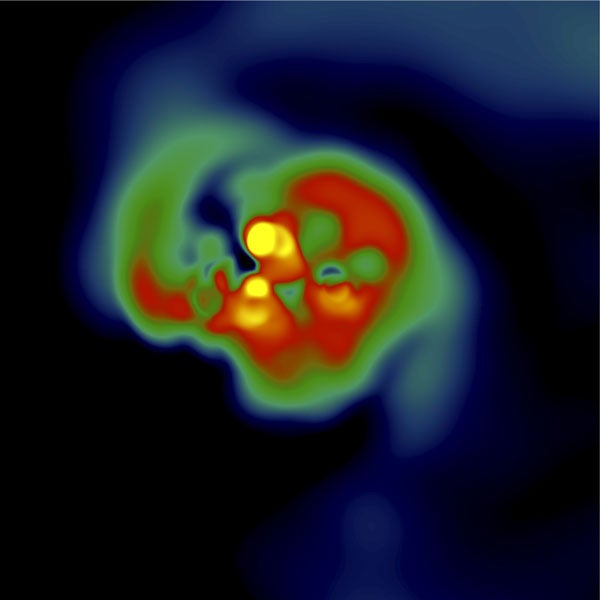“We think that the first generations of massive stars were very fast rotators — that’s why we called them spinstars,” said Cristina Chiappini from the Leibniz-Institut fuer Astrophysik Potsdam (AIP) and the Instituto Nazionale di Astrofisica (INAF).
Massive stars live fast and furious, and, hence, the first generations of massive stars in the universe are already dead. However, their chemical imprints, like fingerprints, can still be found today in the oldest stars in our galaxy. These fossil records are the witnesses of the nature of the first stellar generations to pollute our universe. “It is like if we tried to reveal the character of a cook from the taste of his dishes”, said Georges Meynet from the University of Geneva, Switzerland.
What were these first stars like? Were they different from the stars we observe today?
Soon after the Big Bang, the composition of the universe was simpler than at present as it was made of essentially only hydrogen and helium. The chemical enrichment of the universe with other elements had to wait about 300 million years until the fireworks started with the death of the first generations of massive stars, polluting the primordial gas with new chemical elements, which were later incorporated in the next generations of stars.
Using data from the European Southern Observatory’s (ESO) Very Large Telescope (VLT), the astronomers reanalyzed spectra of a group of old stars in the Galactic Bulge. These stars are so old that only massive, short-living stars with masses larger than 10 times the mass of our Sun should have had time to die and to pollute the gas from which these fossil records then formed. As expected, the chemical composition of the observed stars show elements typical for enrichment by massive stars. However, the new analysis unexpectedly also reveal elements usually thought to be produced only by stars of smaller masses. Fast-rotating massive stars on the other hand would succeed in manufacturing these elements themselves.
“Alternative scenarios cannot yet be discarded, but we show that if the first generations of massive stars were spinstars, this would offer a very elegant explanation to this puzzle,” said Chiappini. Team member Urs Frischknecht from Basel University, Switzerland, is already working on extending the stellar simulations in order to further test the proposed scenario.
The impact of having had an early generation of spinstars in the universe is manifold. Fast rotation also affects other properties of a star, such as its color, lifetime, and luminosity. Spinstars would, therefore, also have strongly influenced the properties and appearance of the first galaxies, which were formed in the universe.
The existence of spinstars is now also supported by recent hydrodynamic simulations of the formation of the first stars of the universe by an independent research group.
“We think that the first generations of massive stars were very fast rotators — that’s why we called them spinstars,” said Cristina Chiappini from the Leibniz-Institut fuer Astrophysik Potsdam (AIP) and the Instituto Nazionale di Astrofisica (INAF).
Massive stars live fast and furious, and, hence, the first generations of massive stars in the universe are already dead. However, their chemical imprints, like fingerprints, can still be found today in the oldest stars in our galaxy. These fossil records are the witnesses of the nature of the first stellar generations to pollute our universe. “It is like if we tried to reveal the character of a cook from the taste of his dishes”, said Georges Meynet from the University of Geneva, Switzerland.
What were these first stars like? Were they different from the stars we observe today?
Soon after the Big Bang, the composition of the universe was simpler than at present as it was made of essentially only hydrogen and helium. The chemical enrichment of the universe with other elements had to wait about 300 million years until the fireworks started with the death of the first generations of massive stars, polluting the primordial gas with new chemical elements, which were later incorporated in the next generations of stars.
Using data from the European Southern Observatory’s (ESO) Very Large Telescope (VLT), the astronomers reanalyzed spectra of a group of old stars in the Galactic Bulge. These stars are so old that only massive, short-living stars with masses larger than 10 times the mass of our Sun should have had time to die and to pollute the gas from which these fossil records then formed. As expected, the chemical composition of the observed stars show elements typical for enrichment by massive stars. However, the new analysis unexpectedly also reveal elements usually thought to be produced only by stars of smaller masses. Fast-rotating massive stars on the other hand would succeed in manufacturing these elements themselves.
“Alternative scenarios cannot yet be discarded, but we show that if the first generations of massive stars were spinstars, this would offer a very elegant explanation to this puzzle,” said Chiappini. Team member Urs Frischknecht from Basel University, Switzerland, is already working on extending the stellar simulations in order to further test the proposed scenario.
The impact of having had an early generation of spinstars in the universe is manifold. Fast rotation also affects other properties of a star, such as its color, lifetime, and luminosity. Spinstars would, therefore, also have strongly influenced the properties and appearance of the first galaxies, which were formed in the universe.
The existence of spinstars is now also supported by recent hydrodynamic simulations of the formation of the first stars of the universe by an independent research group.










